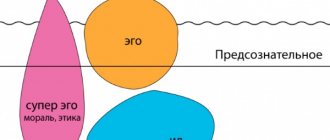Defense mechanisms of the psyche, or psychological defense mechanisms, are unconscious patterns of behavior aimed at preserving the mental health of the individual and internal harmony. They protect a person from trauma, negative emotions and feelings, experiences, and internal conflicts. The concept of “psychological defense mechanism” was introduced by S. Freud.
In modern psychology, there are more than 20 types of defense mechanisms, but in Freud’s classification there were 10. Let’s look at each of these types in more detail.
Identification with the aggressor
What is the operating principle of this mechanism? To stop being afraid of someone, a person becomes just like that someone.
Let's look at it with an example. The child is systematically beaten by his father. Screams, assault, threats - all this is frightening. To stop being afraid, the child himself becomes aggressive. It is possible that next time the father will be beaten.
Another example. Identification with the aggressor is an essential element of Stockholm syndrome. In order not to go crazy under conditions of forced communication with the tyrant, the hostage begins to identify himself with him. This helps to accept the aggressor, which reduces fear. And it also seems to the hostage that the criminal will not touch “his own.”
Notes
- Freud S., “ The neuro-psychoses of defense
” - Freud A., “Psychology of the Self and Defense Mechanisms”, Chapter 4: “Defense Mechanisms”
- Nikolskaya I. M., Granovskaya R. M.
Psychological protection in children. - M.: Rech, 2006. - S. . — 342 p. — ISBN 5-9268-0457-4. - Hall C. (English) (Russian, Lindsey G. (English) (Russian. Theory of Personality
. - New York: John Wiley, 1957. - P. 11. - McWilliams N.
chapter 5: “Primary (primitive) defense processes” and chapter 6: “Secondary (higher order) defense mechanisms” //
Psychoanalytic diagnosis: Understanding personality structure in the clinical process
= Psychoanalytic diagnosis: Understanding personality structure in the clinical process. - M.: Klass, 1998. - 480 p. — ISBN 5-86375-098-7.
Suppression (repression)
With this mechanism, a person seems to forget what causes him pain, makes him feel guilty or ashamed.
These could be some memories, desires of the person himself, thoughts, actions or words. The specificity is that the subject really does not remember this, but at the subconscious level it still lives and affects the person’s conscious behavior in the present.
Example. Psychologists often encounter this phenomenon when working with fears and phobias. For example, a client comes with the following request: “I’m afraid to perform on stage.” And then it turns out that in kindergarten he had a bad experience of performing (he was bullied by his classmates or severely punished by his parents). The person did not remember this incident, but on an unconscious level it continued to influence.
Psychological defense mechanisms
Psychological defense mechanisms (PDMs) are a set of behavioral patterns that are unconsciously (sometimes semi-consciously) built by a person in order to reduce the strength of emotional experiences or maintain the stability of his worldview and the core of his personality.
The reason for the appearance and development of MPD can be either in an attempt to get rid of severe stress, when a person realizes that his life is in danger, or to reduce negative experiences associated with assessing his own personality in his head. It is the psychological defense mechanisms that are the “filters” that support our basic attitudes about ourselves, this world and other people. They are the reason why people find it difficult to change themselves or their attitude towards others.
More interesting articles and direct contact with me - answers to your questions - on my INSTAGRAM! Follow the link and subscribe.
The first description of mental defense mechanisms was given by S. Freud. Not all of them lead to negative consequences for a person, but most MPH operate on the principle of “postponing for later” the problem that caused a strong surge of emotions and the stability of the psyche was shaken, in order to preserve it.
Repression
Repression is a form of psychological defense in response to a strong “overload” of acute, unpleasant emotions (fear for one’s life, a situation completely uncontrollable by a person, something frightening and beyond logical explanation). At the same time, what provoked the emotional outburst is redirected to the subconscious along with the sensations that arose. Repression is a common model of defense against psychological trauma in childhood. It forms “splits” in the relationship between feelings and the situation in which they appeared, causing the development of neuroses, anxiety and psychosomatic diseases. Strong but unacceptable emotions can also be suppressed: irritation or anger at a spouse, children, boss, etc.
Compensation (overcompensation)
Compensation is the desire to “cover up” and make up for the characteristics (or shortcomings) of appearance, character and communication skills through consistency in a particular area. The mechanism of compensation and dissatisfaction with oneself becomes an incentive for a person to achieve higher achievements in another, preferably generally recognized in society, area: to become rich, have great power, gain recognition and popularity, etc. The “problem” of compensation is that it is not “ resolves the primary internal conflict that causes a person to be dissatisfied with himself, and as a result, all received and achievements may be devalued. Another scenario is that a person can “abandon” a useful activity as soon as he gets the first result, then return to the “initial state” and again be dissatisfied with himself (which happens with people who play sports only to raise their self-esteem).
Projection
Projection is the “removal of responsibility” from oneself through assigning one’s own negative character traits or behavior to others. It is very difficult for a person to recognize and accept character traits that are condemned in society (envy, aggressiveness, quarrelsomeness, etc.). By redirecting and attributing these traits to other people, a person temporarily relieves tension and internal conflict (“Am I really bad?”), but in the long term this leads to a deterioration in relationships with others. In addition to “idealizing” himself, a person can idealize his partner, attributing to him something that actually does not exist. The result is deep disappointment in oneself or people when a person is faced with a situation where the projection no longer “works.”
Other types of projection are also possible - for example, redirecting unacceptable sexual desire to some object (fetishism), etc.
Identification with the aggressor
Identification with the aggressor is more commonly known as Stockholm syndrome when traumatic events occur in adulthood. If a threatening or shocking situation occurred in early childhood (the child became a victim or witness of violence), identification can occur according to the “direct type” - when, as a defense, the child chooses a narcissistic model of worldview (I am important, others are not important), and accepts the decision to become an “arbiter of justice.” Many maniacs who were subjected to bullying and violence in their families and schools acted according to this principle. Most of them saw themselves as “superheroes” who rid this world of vile “offenders.”
Negation
Denial is a defense mechanism that maintains the constancy of perception of oneself and the world around us. It is based on the fact that our consciousness does not “perceive” the dual nature of feelings and things, and strives to simplify the phenomena of life and fit them into “its own coordinate system.” Unlike projection, where a person seems to “shift” his negative feelings onto others, saying “that’s who they are!” and “everyone does it!”, denial is simply the rejection of the imperfection of oneself, a significant person or point of view. The thesis that can be used to define it: “This doesn’t concern me, I have nothing to do with it!” This mechanism also reduces self-criticism and the ability to adequately evaluate one’s actions.
Removal
Displacement (replacement) is the “draining” of negative emotions from the object that caused them (boss, relative, etc.) onto another person, animal or object. Usually the object for “releasing steam” is chosen to be defenseless: it could be a wife, children (those who are financially or otherwise dependent on the person), a pet, etc. One form of displacement is auto-aggression (guilt).
Formation of reaction
The formation of reactions is a defense mechanism designed to “concretize” feelings and emotions towards someone if they were initially ambivalent. According to this principle, mutual hatred can develop into passionate love, and one of the partners in a couple can love the other to the point of obsession, despite suppressed contempt for him (for example, in the case of his infidelity).
Reactions also arise as a “transformation” of negative, but socially condemned emotions. For example, a latent homosexual, suppressing his feelings, may demonstrate ardent homophobia; a person who hates his mother for a spoiled childhood can be very protective of her in old age, etc.
Depreciation
Devaluation is mainly used to “reduce” the achievements of other people and artificially increase one’s own importance. This is a popular “tool” for controlling and maintaining self-worth among individuals with narcissistic traits and unstable self-esteem.
Devaluation of feelings and emotions is often instilled in us since childhood, and serves as one of the mechanisms of “control” over them. For example: “it doesn’t hurt that much” - in response to the cry of a child who has hurt his leg. Often, devaluing others works as manipulation in order to keep a partner close to you in a toxic relationship: “Who needs you like that.” People often devalue each other’s work: “What did you earn there?”, “Is staying at home with children a job?” etc. The negative from devaluation is that a person “does not give permission” to feelings and emotions, cutting off the very opportunity to enjoy life. As a result, nothing is important, valuable or meaningful to him. Such people live the “life of a loser”, being eternally dissatisfied with their choices, be it family, work, etc.
Regression
Regression is a return to behavioral patterns from childhood. People with hysterical or paranoid accentuation are more prone to it. This psychological defense mechanism serves as an attempt for a person to shift responsibility to others, or to obtain secondary benefits through immature behavior.
Regression is expressed as a holistic “rollback” of the personality to a previous stage of development in order to temporarily escape from problems. A typical scenario for people subject to regression is constantly falling into toxic relationships, addiction to psychoactive substances, etc., when a person idealizes himself and his actions, is unable to detect cause-and-effect relationships in his life and learn from mistakes.
When manifested too clearly, regression leads to the “erasure” of moral and ethical norms and principles, the denial of one’s own unseemly actions in order to somehow shift responsibility for one’s life onto someone else.
Rationalization
Rationalization is a person’s search for any arguments, statistics and other reasons “in favor” of behavior that is disapproved in society or causes direct harm. A person becomes the “devil’s advocate”, justifying smoking or alcoholism by the fact that a bad environment has a worse effect on the body than these habits. At the same time, the person himself is sincerely convinced that this is so.
Inversion
When psychological trauma occurs, fear and other negative emotions shift from one object to another. In this way, tension is relieved or a warning of danger occurs, or both at the same time. First there is repression. The main problem begins to free consciousness. Negatively colored emotions are weakened (repressed and displaced), which allows the body to cope with everyday tasks.
In the case when the stressful situation has receded, or when displaced and undisplaced emotions (problems) interfere with the solution of more significant issues, “inversion” occurs - the replacement of negative emotions with positive ones. And on the basis of these positive emotions, motivation already arises. The behavior changes to the exact opposite: avoidance behavior changes to achievement behavior. What was previously rejected and caused unpleasant emotions now arouses interest, a desire to possess it.
For example, a child (Ksyusha) at school, due to a conflict with the teacher, had a negative attitude towards learning. The situation seemed impossible to resolve until one incident occurred. Ksyusha decided to take part in the school theater group. She really enjoyed rehearsing and performed successfully at the school gala. After that, she felt the acceptance and sympathy of others, and a special attitude towards herself. And after this event, Ksyusha felt embarrassed to be a lagging student and she decided to study well. Under the influence of strong motivation, a negative attitude towards learning was replaced by a positive one (an inversion occurred). With the emergence of interest in studying and the emergence of first successes, relationships with teachers improved (that is, the main problem also began to be resolved).
Sublimation
Sublimation is the redirection of certain drives (usually condemned in society) into a creative direction, or the “dumping” of negative emotions (anger, rage, resentment, shame, etc.) through creative activity. Freud considered the sublimation of sexual desire to be the basis of all forms of art. A well-known type of sublimation is getting rid of accumulated aggression or anger through physical exercise, any active activity (this also has an additional “bodily” aspect, helping to reduce the level of adrenaline in the blood and relieve stress at the hormonal level).
Often, in order to sublimate specific drives, a person chooses a profession that, to some extent, allows him to express his “inclinations”:
- Sadistic tendencies can indirectly push a person to choose a surgical specialty;
- The tendency to act violently and cause harm becomes an “incentive” for choosing work in law enforcement agencies (army, police, etc.);
- Personal problems, difficulties of self-identification, etc. often push people to “search for themselves” through visual, musical and other forms of art.
Most of the primary stimuli for sublimation find their imprint in memories from childhood that are traumatic or difficult for the child to understand and comprehend.
If you need advice from a professional psychologist, sign up using the form on the website or write to WhatsApp +79269164230.
Share:
Negation
The subject denies what he cannot accept.
He refuses to even hear about what could hurt him: “No, he couldn’t do that,” “I don’t believe it,” “It didn’t happen,” “I didn’t notice it.” For example, people can be in broken relationships for a long time, denying obvious betrayals, misunderstandings and much more. A person really does not notice what can harm his mental health.
Denial is often combined with another mechanism – rationalization.
History of the concept
The term was first coined by Freud in 1894 in his work "Defensive Neuropsychoses"[1] and was used in a number of his subsequent works to describe the struggle against painful or intolerable thoughts and affects. Initially, Sigmund Freud meant by it primarily repression, but in 1926, in the appendix to Inhibitions, Symptoms and Anxiety, he returned to the old concept of defense, arguing that its use has its advantages, “ since we introduce it for a general designation for all techniques that are used in conflict and that can lead to neurosis, reserving the word “repression” for a special method of defense, which was best studied by us at the initial stage of our research.”
[2]. It was later developed in more detail by other psychoanalysts, most notably Anna Freud. At the moment, this concept, in one form or another, has entered the practice of most psychotherapists, regardless of the direction of psychology that they adhere to.
Compensation (overcompensation)
With this type of defense, a person compensates for dissatisfaction with something in another area.
For example, a physically weak boy develops intellectually and asserts himself through victories at the Olympiads. Or a person who cannot improve his personal life compensates for this with luxury goods and money.
Overcompensation is the excessive development of what causes worries. For example, a shy person becomes hypersocial. An insecure girl behaves provocatively and dresses revealingly.
Regression: returning to childhood
The regression mechanism allows you to adapt to a traumatic situation of conflict, anxiety or pressure by returning to behavioral practices familiar from childhood: screaming, crying, whims, emotional requests, etc. This happens because we, as a rule, learn early that they guarantee support and safety. Demonstration of defenselessness, pain, and inferiority very often brings psychological “dividends” - after all, people, like other living beings, at the neurophysiological level tend to protect the weak and small - that is, offspring, and not only their own.
Regression allows us to throw off the burden of responsibility for what is happening: after all, in childhood, our parents are responsible for a lot of things instead of us. This protective mechanism can be called very effective and quite problem-free. Difficulties arise when he works for too long. Abuse of regression leads to the appearance of psychosomatic diseases, hypochondria, lack of a successful life strategy, and destruction of relationships with other people.
Projection
This is the attribution of personal thoughts, feelings, desires, and motives to other people.
Moreover, only what a person for some reason forbids himself, does not recognize or cannot receive.
Example: grandmothers sitting on a bench and shouting that Masha dressed up like a girl of easy virtue, and indeed that’s exactly what she is. Grandmothers themselves would be happy to dress like that and go to the club, but the years are not the same, the body is not the same, etc.
Another example. A person is capable of betrayal and often does so with his friends. However, he does not recognize this in himself, and therefore says to his friend: “Yes, you want to betray me.” In fact, it was he who was about to betray this friend.
Rationalization
Explain your irrational behavior with reasonable reasons. Rationalization helps justify your mistakes and misdeeds in the eyes of others. This mechanism serves, first of all, to preserve and protect self-esteem. Let's say a student who fails a session explains this by saying that he doesn't really want to study in his specialty.
Rationalization also helps to cope with frustration by providing explanations for those actions of people that can cause pain and suffering if understood correctly. For example, a rejected man explains his failure by saying that the woman is stupid and ugly.
This mechanism extinguishes anxiety and helps to find arguments and logic in one’s own unacceptable behavior or desires.
Substitution
This is the venting on a random person of those emotions, feelings, thoughts that the subject experiences in relation to another person.
In this case, the first person is not physically or psychologically available, but the second person is always at hand.
Example. An employee dreams of hitting his boss or at least yelling at him. But he cannot do this for fear of punishment or dismissal. Substitution turns on and he splashes out aggression on his wife and children.
Energy can be directed not only to people, but also to objects.
Fantasies: Brave New World
Fantasies allow you to temporarily improve your emotional state through the work of your imagination. Daydreaming, reading, computer games, and even watching porn give us the opportunity to move from a difficult situation to a place where we feel more comfortable. From the point of view of psychoanalysis, the emergence of fantasies is due to the desire for fulfillment, satisfaction and fulfillment of desires that cannot yet be satisfied in the real world.
Fantasies absorb suffering and help calm the personality. Nevertheless, the psyche is not always able to fully recognize where reality ends and the imaginary world begins. In the era of information technology development, a person can enter into a relationship with a media image, dreaming about his favorite actress or interacting with his favorite computer game character. The destruction of such relationships due to unsuccessful contact with the real content of the image or unpleasant situations will be experienced as a real loss and will bring emotional pain. Fantasies can also distract a person from the real world. At the same time, they often become fertile soil for creativity and form the basis of successful works, bringing positive results in reality.
Sublimation
This is the redirection of destructive energy (sexual attraction, negative or positive, but unexpressed emotions) into creativity.
Sports, music, drawing, writing poetry - all this and any other creativity is an example of sublimation. This is the most harmless and useful defense mechanism.
It is believed that one cannot completely get rid of defense mechanisms. Periodically they will still turn on, and sometimes several at once. However, if they are included in the work too often, then they need to be replaced with conscious coping strategies. Otherwise, the person will be a hostage to neurosis.
Auto-aggression: blaming yourself
Auto-aggression, or turning against oneself, is a very destructive defense mechanism. It is often characteristic of children experiencing difficult moments in their relationships with their parents. A person may have a hard time accepting that their parent is being dismissive or aggressive towards them, and instead assume that they are the bad ones. Self-blame, self-deprecation, self-harm, self-destruction through drugs or alcohol, and overindulgence in the dangerous aspects of extreme sports are all results of this mechanism.
Auto-aggression occurs most often when our survival or well-being depends on the external object that caused its appearance. But despite the many negative consequences of this process, from an emotional point of view it can be better tolerated than aggression directed at the original target: a parent, guardian or other important figure.











